One of the key features of renewable energy generation is its benefit to the environment through developing low carbon power sources, so it’s important to develop new types of renewable energy in environmentally responsible ways. Collecting and analyzing environmental data necessary for marine energy projects is difficult – the areas of interest are highly energetic, with (typically) little existing information, while the devices themselves do not have a long track record of deployment so there are high uncertainties in the possible effects. The US Department of Energy has recognized the importance of the environmental monitoring for such projects, and is funding the Triton Initiative at the Pacific Northwest National Laboratory (PNNL) marine laboratory, which will help advance environmental understanding and help address regulatory issues.
Triton is an initiative that specifically supports technology development for environmental monitoring around marine and hydrokinetic energy devices. This development includes sensor modifications, deployment methods, and software improvements. The support covers a range of activities, from information gathering, to algorithm development, to field testing – enabling a wide range of technology advancements. Encouraging collaboration and sharing information is at the core of the initiative.
Four main environmental topics have been identified as priorities:
- Acoustic output (e.g., measuring the noise from the devices);
- Electromagnetic fields (e.g., measuring the fields generated by the devices and the cables under different conditions);
- Animal interaction with devices (e.g., fish and mammal detection near turbines or wave energy converters); and
- Sensor integration (combining instruments that measure different variables, such as flow/sound/video, and interpreting the information to collect more meaningful data)
Projects supported to date have included:
- Developing software to translate data from sonar devices into a standardized system, and to analyze the target information and tracks;
- Testing sensor integration and communication among instruments;
- Assessing the feasibility of measuring fish collision in the field;
- Testing passive hydrophones that extract the real sound signals generated by a device from pseudo-noise; and
- Analyzing video to monitor fish around a turbine, and developing software to improve automated analysis.
Future projects that will be supported include:
- Developing drifting and moored acoustic sensors, and improving data processing and analysis from these sensors;
- Adapting electromagnetic field sensors for deployment in highly energetic environments;
- Studying animal interaction with devices using sonar and LiDAR techniques; and
- Improving operational and software techniques for habitat mapping.
For more information, visit https://triton.pnnl.gov/.

Igiugig, AK.This video is being used to develop and test algorithms to automate
video data processing in order to examine the number of fish that encounter the turbine
as well as associated behavior and interactions.
